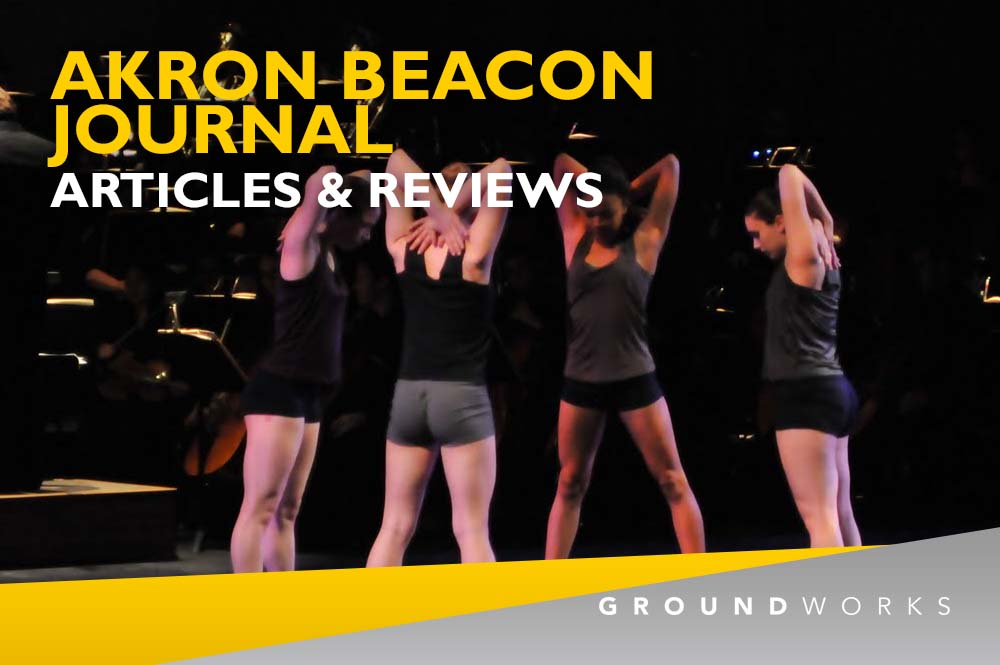Project Description
Akron Beacon Journal – ‘Rite of Spring’ still stirs passions 100 years later (Preview)
By Kerry Clawson, Akron Beacon Journal
Forty fifth-graders twisted and curved their bodies around in a cluster on their lunchroom floor around dance educator Mark Otloski as he instructed, “Imagine yourself to be a seed in the dirt. I want you to emerge slowly from the ground.”
“I want to see your creation, I want to see your imaginations and I want to see your movement,” Otloski said.
“I sprouted,” Dakota Herbert proudly announced after slowly shooting up from the mass of twisting seeds on the floor.
The exercise was part of an hour-long outreach program last month sponsored by GroundWorks DanceTheater and the Akron Symphony Orchestra, to engage the community in preparation for their upcoming collaboration on The Rite of Spring on Saturday, a new dance set to the groundbreaking music of Russian composer Igor Stravinsky.
The concert, which will celebrate the 100th anniversary of the incendiary work’s debut in Paris, will be the first time the Akron Symphony has performed the masterpiece as it was originally presented — in a full-scale production with dance.
“I’ve been excited about doing The Rite of Spring as a dance work for as long as I can remember, and to this day, I’ve still never seen the work performed live by a dance company,” Akron Symphony Music Director Christopher Wilkins said. The project, which focuses heavily on community participation, furthers earlier work the Akron Symphony has done by bringing in Akron-area performers to produce the opera Porgy and Bess and the musical Titanic.
For The Rite of Spring, the eight-member, professional GroundWorks company will perform in collaboration with a 15-member student dance ensemble, with the 100-member Akron Symphony also on the E.J. Thomas Hall stage.
GroundWorks artistic director David Shimotakahara has choreographed a new Rite of Spring dance that brings these diverse dancers together for a performance that promises to be wholly original.
Workshops for Youths
Leading up to the big performance, GroundWorks conducted workshops in March at Resnik and Betty Jane elementaries, Firestone High School, Miller South School for the Visual & Performing Arts and the Cuyahoga Valley Youth Ballet focusing on the interplay between instrumental music and dance in The Rite of Spring.
At Resnik on March 12, Akron Symphony bassoonist Todd Jelen of Berea played live as Otloski — who spent 22 years as a principal dancer with the Cleveland Ballet — talked about the historical significance of the work in the worlds of music and dance.
Stravinsky, born to a musical family in 1882 in Russia, was a student of Rimsky-Korsakov. Stravinsky was commissioned by Serge Diaghilev, impresario of the Ballet Russe, to create The Rite of Spring, which came to Stravinsky as a solemn pagan rite occurring during the surge of spring. The original dance was choreographed by Vaslav Nijinsky. Akron’s Rite of Spring performance will come just shy of the exact 100th anniversary of the world premiere, which occurred May 29, 1913, at the Theatre des Champs-Elysees in Paris.
“Paris in 1913 was like the hotbed of the arts in Europe,” Otloski said. At the Resnik workshop, Otloski played recordings illustrating how romantic and flowing ballet music was up until The Rite of Spring, including Stravinsky’s own Firebird. The Rite of Spring took the world by storm with its internal tension created by discordant harmonies, sharp dissonance, irregular meters and short, repeated rhythms. Jelen demonstrated to the students with solo bassoon how Stravinsky wrote for the extreme top range of the instrument, which created a strange tone to 1913 ears.
The result was so revolutionary, a riot broke out in the Paris theater at the premiere.
“The music was very dissonant — they didn’t like it,” Otloski said of the raucous audience. The orchestra was drowned out and the dancers couldn’t hear the music. Nijinsky pounded on the scenery with his fists in an effort to keep the dancers together, and Stravinsky and Diaghilev stood at either side of the stage and shouted out counts, Otloski said.
Stravinsky had to leave the auditorium and pace backstage in the wings for most of the performance, according to Richard E. Rodda, who wrote the program notes for Akron’s upcoming performance.
Still a Masterpiece
“A hundred years later, it’s still considered to be a masterpiece both musically and choreo¬graphically,” Otloski told Resnik’s fifth-grade students about the piece last month. Among them was Monique Denefield, who is among 15 students chosen to perform in The Rite of Spring. Dancers ages 10 through 23 were selected in the fall in auditions/workshops at nine Akron-area locations in an effort to draw in dancers with a range of ages and backgrounds.
The ensemble, which has been rehearsing at the University of Akron since February, includes dancers from Resnik, Betty Jane, Miller South, Firestone High School, the University of Akron, Kent State University, the Cuyahoga Valley Youth Ballet, Nan Klinger Excellence in Dance and the Dance Institute. They are Denefield, Sadie Tritt, Emma Gentner, Klaire Morgenstern, India Nunn, Gracie Benson, Rebekah Gray, Arielle Farina, Emily Koch, Nina Price, Scotto Hamed-Ramos, Nyah Malone, Emma Oplinger, Kali Oliver and Tori Lang.
“We winnowed it down to the kids who I felt really wanted to do this and showed some ability. I’m really excited about that,” Shimotakahara said. For this new adaptation of The Rite of Spring, the GroundWorks company of Felise Bagley, Noelle Cotler, Damien Highfield, Gary Lenington and Annika Sheaff has been supplemented by local dancers Alana Austin, Kristy Clement and Anna Trumbo.he student ensemble is an integral part of the performance, dancing in eight of the 14 movements in the 40-minute work.
Story Reimagined
Shimotakahara has rethought the original story, which tells of primitive people selecting and sacrificing a virgin to the gods of spring. The girl, the Chosen One, must dance herself to death. “I just didn’t want to use that,” Shimotakahara said. “The idea that she’s a sacrificial maiden, the Chosen One, I just thought she’s a victim. I wanted to see if we could think about [it] a little bit differently.
“What if she wasn’t chosen but what if she made the choice herself?” Shimotakahara said. “I call her the Other. I got into the idea of individual choice instead of this monolithic group.”e continued, “If there is a story, it’s symbolic. It’s about individual choice versus this sort of group mentality. Everyone deals with that throughout our entire lives.”
For Shimotakahara, the hope in the dance lies in the desire to make choices, despite external forces. The newly conceived dance doesn’t reference a particular culture, time or place. The E.J. Thomas performance will include a live video feed that will provide close-ups of the musicians and dancers.
“We’re doing something that’s very, very minimalist. But the movement itself is also very primal,” Shimotakahara said.
Dance Rehearsal
At a student dance rehearsal March 10, Shimotakahara worked on blocking, with the dancers marching in five different groups. He asked the students to listen for a sustained note after a crash in the complex music and guided them through counting their section. As the dancers traveled across the stage in two opposite groups, they rhythmically hit their thighs with their palms and then crossed their arms back behind their shoulders to make more percussive sounds with their bodies. “You’ve got to leave the impression that you are beating those drums,” Shimotakahara said, asking them to exaggerate their steps and make noise with their feet on the floor.
Next the dancers lined up in pairs, taking the arm of the person next to him or her and bending low as they leaned to each side. “It’s as if something’s trying to pull you apart. I want you to feel this,” Shimotakahara said. By aiding the dancers in rhythmically organizing the immense score, he hoped to help them understand the music and respond to it in a physical way.
Wilkins hopes that the audience, too, will gain a new appreciation for Stravinsky’s seminal work through the rare opportunity to take in the whole orchestra and dancers in full view on the E.J. Thomas stage.
“That’s exciting. I think people will come away with an experience they will always remember. And I know the dancers and orchestra will never forget it,” he said.
Arts writer Kerry Clawson may be reached at 330-996-3527 or kclawson@thebeaconjournal.com.

